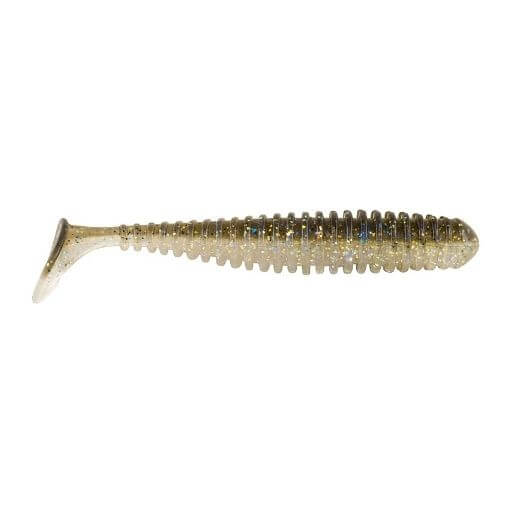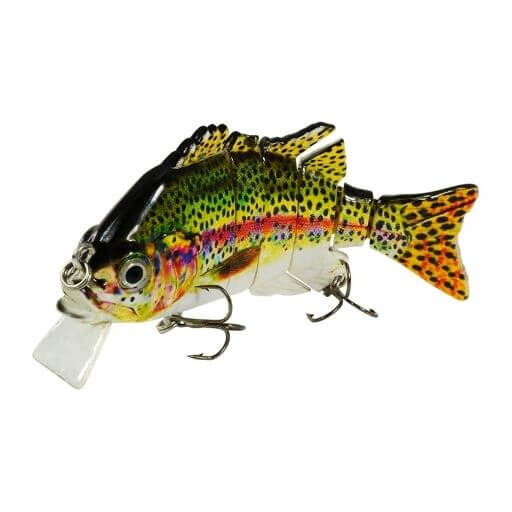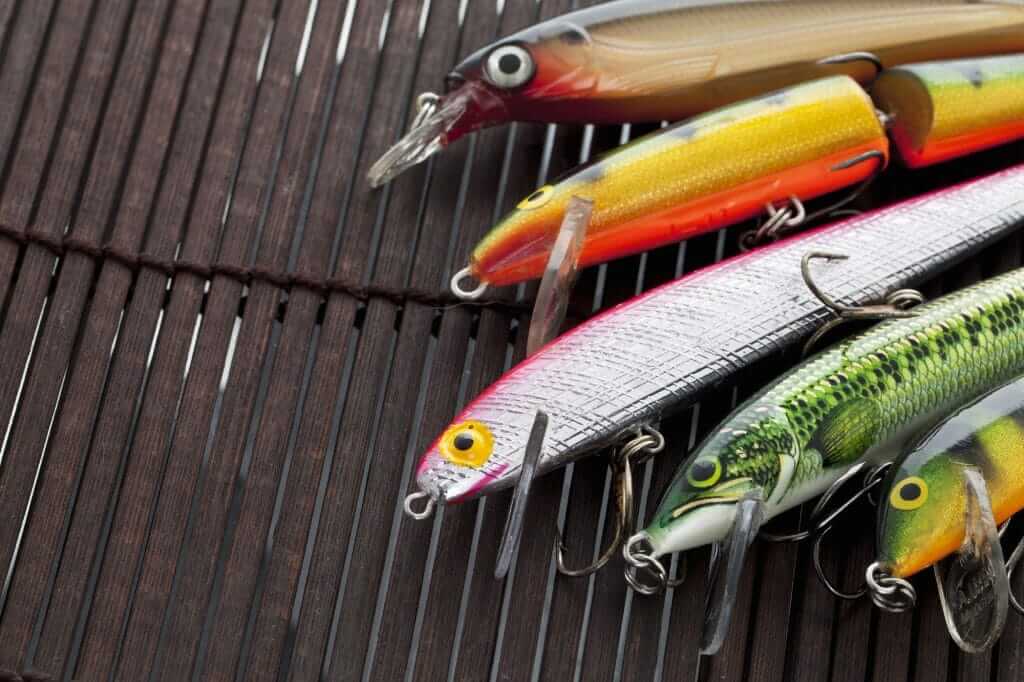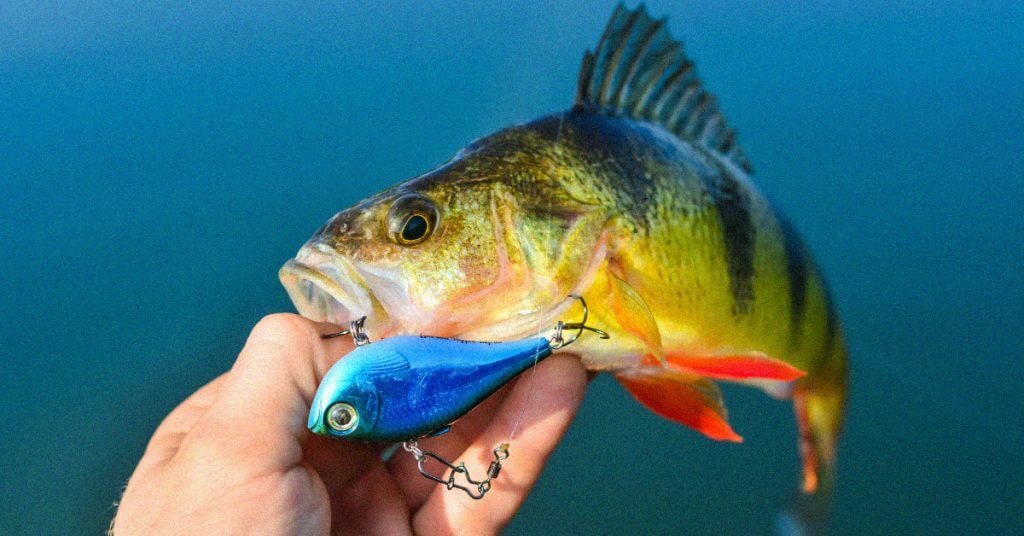The truth about trophy swimbaits? Most are overpriced gimmicks. Here’s what actually works for big bass – and the deadly retrieve most anglers never try.
Video Review
If you’d rather watch a YouTube video, check out this Anglers.com video by Wesley Littlefield where he gives us his favorite swimbaits.
Berkley PowerBait Power Swimmer

BEST OVERALL
Most swimbaits just swim – but what if your bait could actually call fish in from a distance?
That’s where the Power Swimmer‘s unique ribbed body design changes the game.
The sophisticated vibration pattern triggers bass’ lateral lines like a dinner bell, while PowerBait’s exclusive scent technology creates an irresistible scent trail that draws curious bass from yards away.
When they arrive, the bait’s natural profile and swimming action closes the deal.
What sets this 3.8″ to 4.3″ soft plastic apart is its unique ribbed body design, which creates irresistible vibrations that trigger bass’ natural hunting instincts.
Rose Kuli Multi-Jointed Bass Swimbait

BEST JOINTED SWIMBAIT
Trophy bass have always fascinated me, and that’s what initially drew me to the Rose Kuli Multi-Jointed Swimbait.
At 4.1 inches, it’s larger than typical pond offerings, but that’s exactly what helps it target bigger bass that often ignore smaller presentations.
Most jointed swimbaits struggle to create consistent action, but this one’s engineering stands out.
The segmented body generates a natural S-swimming motion that, combined with the outward-swinging treble hooks, produces solid hookups when bass come.
Realistic 3D eyes and detailed color patterns aren’t just for show – they make a real difference in clear water when bass have time to inspect their prey.
Megabass Magdraft
BEST SOFT SWIMBAIT
The difference between a good swimbait and a great one often comes down to the smallest details. When I first heard about the magnetic hook system in the Megabass Magdraft, I was skeptical – until I saw how it transformed the bait’s action in the water.
I’ve thrown countless swimbaits over the years, and they all share a common problem: that dangling treble hook that ruins the profile and snags everything in sight. The Magdraft’s magnetic system solved this by tucking the hook cleanly against the belly.
Not only does this create a more natural presentation, but I’ve found it significantly reduces snags when I’m working it through grass and brush – places where big pond bass love to ambush their prey.
While it’s definitely a premium-priced bait, the construction quality and unique features have made it a consistent producer in my pond fishing arsenal, especially when I’m targeting those cautious, bigger bass that have seen it all.
Storm Arashi Glide Bait
BEST GLIDEBAIT
The first time I watched a bass track the Storm Arashi glide bait through clear pond water, I realized most glide baits I’d been using were just pale imitations of the real thing.
While other glide baits promise natural action but deliver unpredictable movement that spooks pressured fish, the Arashi’s engineering solves the biggest challenges that have plagued glide bait design for years.
What frustrates many anglers about glide baits is their tendency to track erratically or roll at slower speeds. The Arashi’s triple hinge-pin design solved this issue. I’ve found its slightly head-down posture and consistent 0.4-second-per-foot sink rate lets me work every depth zone effectively.
When big bass are suspended under pond docks or hovering near deep structure, this controlled descent has helped me put the bait right in their strike zone.
The included spare tail is a thoughtful touch, though I haven’t needed it yet. While it’s a bit pricey, its versatility across different conditions and ability to trigger strikes from pressured pond bass has earned it a permanent spot in my tackle box.
Goto Swim Minnow
BEST SWIMBAIT FOR SMALLMOUTH BASS
Ever faced the dilemma of choosing between durability and action in a swimbait? After throwing countless jig head swimbaits over the years, I’ve found this Goto minnow swimbait to provide a few unique features.
The black nickel jig head and hook provide solid hookups, and the soft body creates an enticing action that draws aggressive strikes when retrieved at higher speeds. Among the five color options, you’ll find some uniquely vibrant patterns that, while not exactly matching any natural forage, can trigger reaction strikes in the right conditions.
What really makes this bait worth considering is its price-to-performance ratio. While it may not have the longevity of more expensive options, its ability to trigger strikes from aggressive smallmouth has earned it a place in my rotation, especially when I’m expecting heavy fish activity and don’t want to risk losing premium baits.
How I Chose The Best Swimbait

Start by observing the baitfish in your water – their size, color, and swimming patterns. This will help you narrow down your choices significantly.
For clear water, opt for more natural, realistic patterns and smaller profiles (3-4 inches). The fish have a better view of your bait, so detail matters. In stained or murky water, choose larger profiles (4-5 inches) with brighter colors or added flash to help bass locate the bait.
Consider the cover you’re fishing around. Heavily wooded or weedy areas call for weedless single-hook designs or those with hook guards. Open water allows you to throw treble-hooked baits that offer better hook-up ratios.
Your retrieve speed also influences choice. Slow-rolling calls for baits with natural action at low speeds, while power fishing requires durably constructed baits that maintain their action at higher speeds.
Final Thoughts
When it comes to swimbait fishing, I’ve found success boils down to matching your presentation to the conditions you’re facing.
For those clear-water days when bass are actively feeding, I’ll typically start with a natural-colored glide bait like the Storm Arashi. In stained water or around heavy cover, the weedless design and durability of the Berkley PowerBait Power Swimmer consistently produces.
Want to dial in your swimbait game for your local waters? Drop a comment below describing your pond’s characteristics – things like water clarity, typical forage, and the type of cover you’re fishing. I’ll share specific techniques and bait selections that have worked for me in similar situations.
I check these comments daily and love helping fellow anglers unlock the full potential of swimbait fishing. There’s nothing quite like the thrill of a big bass crushing a perfectly presented swimmer!





